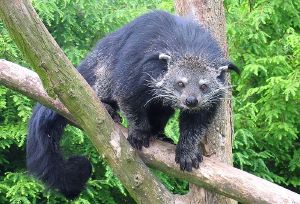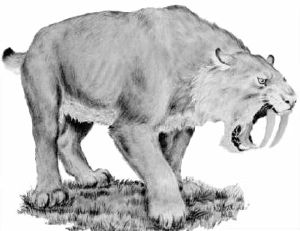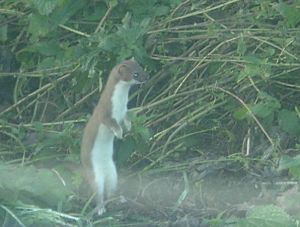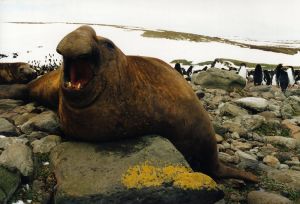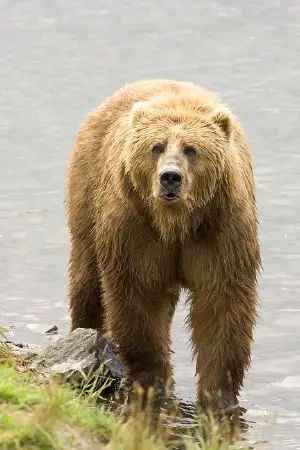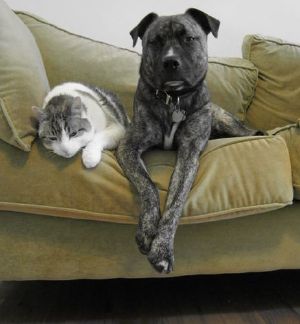Difference between revisions of "Carnivora" - New World Encyclopedia
Rosie Tanabe (talk | contribs) |
|||
| (12 intermediate revisions by 5 users not shown) | |||
| Line 1: | Line 1: | ||
| − | {{ | + | {{Paid}}{{Approved}}{{Images OK}}{{Submitted}}{{copyedited}} |
{{Taxobox | {{Taxobox | ||
| color = pink | | color = pink | ||
| Line 6: | Line 6: | ||
| image = Canis lupus laying in grass.jpg | | image = Canis lupus laying in grass.jpg | ||
| image_width = 200px | | image_width = 200px | ||
| − | | image_caption = [[Gray Wolf]] | + | | image_caption = [[Wolf|Gray Wolf]] |
| regnum = [[Animal]]ia | | regnum = [[Animal]]ia | ||
| phylum = [[Chordate|Chordata]] | | phylum = [[Chordate|Chordata]] | ||
| Line 17: | Line 17: | ||
| ordo = '''Carnivora''' | | ordo = '''Carnivora''' | ||
| ordo_authority = Thomas Edward Bowdich, 1821 | | ordo_authority = Thomas Edward Bowdich, 1821 | ||
| − | | subdivision_ranks = | + | | subdivision_ranks = Families |
| subdivision = * 17, See [[#Classification|classification]] | | subdivision = * 17, See [[#Classification|classification]] | ||
| }} | | }} | ||
| − | + | '''Carnivora''' is an [[taxonomy#Scientific or biological classification|order]] of [[mammal]]s that includes such familiar groups as [[dog]]s, [[cat]]s, [[bear]]s, and [[seal]]s. There are over 260 species in Carnivora. | |
| − | + | The word "Carnivora" comes from the Latin words ''carō,'' meaning "flesh," and ''vorāre,'' meaning "to devour," and thus means "to devour flesh." Carnivores in general get most of their food by killing and eating other animals, including other mammals, [[bird]]s, [[insect]]s, and [[fish]]. However, many are omnivores and get a large part of their nutrition from plant foods. The [[giant panda]] (''Ailuropoda melanoleuca'') and a few other members of Carnivora are almost exclusively [[herbivore]]s. (The panda occasionally eats fish, eggs, and insects.) | |
| + | |||
| + | While the term '''carnivore''' is popularly (and acceptably) used to refer to any meat-eating animal, in [[taxonomy]] the name "carnivore" specifically refers to any member of the order Carnivora, including those that are herbivores. However, in this article, the term carnivore will be limited specifically to members of Carnivora. | ||
| + | |||
| + | Carnivores are a key part of the remarkable harmony in [[nature]], where an incredible [[biodiversity|diversity]] of [[plant]]s, [[animal]]s, and [[microorganism]]s exist, all in stunning balance and for millions of years. One explanation for this continuing harmony is the fact that the various taxa not only seek their own individual purpose (survival, maintenance, reproduction, etc.), but also serve a purpose for the whole. In the case of carnivores, by consuming various animals lower in the [[food chain]], they help to maintain acceptable population levels. Removal of carnivores (and many are apex predators, at the end of the food chain) and the prey populations could explode in numbers and overwhelm the [[ecosystem]]. Human activities sometimes result in removal of important carnivores, and even [[extinction]] of particular populations or [[species]], disrupting the delicate balance. | ||
| + | |||
| + | Members of Carnivora are placed into two main sub-orders: '''Feliformia''' (cat-like) and '''Caniformia''' (dog-like). Some of the major sub-groups within Feliformia are the families Felidae (cats), Hyaenidae ([[hyena]]s), and Herpestidae ([[mongoose]]s). Some of the major sub-groups within Caniformina are the families Canidae (dogs, [[wolf|wolves]], and [[fox]]es), Ursidae (bears), Mustelidae ([[weasel]]s, [[badger]]s, and [[otter]]s), and Mephitidae ([[skunk]]s), as well as the [[pinniped]]s (seals, [[sea lion]]s, and [[walrus]]es). | ||
==Characteristics== | ==Characteristics== | ||
| + | [[Image:Binturong in Overloon.jpg|thumb|Binturong or bearcat]] | ||
| + | Carnivores have a characteristic skull shape. Their [[dentition]] includes prominent canines and carnassials, while the molars are blade-like and more suited for cutting than grinding. Carnivores, unlike many other mammals, can not move their lower jaws from side to side but can only open and close their mouths. | ||
| − | + | Except for the aquatic [[pinniped]]s, which have both front and hind limbs in the form of flippers, carnivores walk on all four legs. Some, like [[cat]]s and [[dog]]s, walk on their toes, and some, like bears and raccoons, on the flat of the feet like [[human]]s. The bodies of most are covered with thick [[fur]]. Almost all carnivores have tails, which are used in various ways by different species. The binturong, or bearcat (''Artictis binturong''), has a prehensile tail (Voelker 1986). | |
| − | |||
| − | |||
| − | + | Most carnivores bear young once a year. The number of young ranges from one, in the [[Pinnipedia]], to as many as 16 or more, in the African wild dog (''Lycaon pictus''). The young are born small and helpless and are looked after for a fairly long time by their mothers. In most cases, this includes time for learning hunting and other life skills. Some carnivores, such as wolves (''Canis lupus'') and [[lion]]s (''Panthera leo''), live in groups and help each other rear and protect the young (Nowak 1983). | |
| − | All | + | All carnivores have scent glands in their anal regions. The secretions from these are often used to mark territories. In [[skunk]]s and some others, they are used as a defensive weapon (UCMP 2007). |
| − | + | Carnivores range in size from the least weasel (''Mustela nivalis''), which weighs from 35 to 70 grams (1.25 to 2.5 ounces), to the Southern elephant [[seal]] (''Mirounga leonina'') which can weigh 4000 kg (9000 lbs). The largest land carnivore is the brown or grizzly [[bear]] (''Ursus arctos'') which can weigh as much as 780 kg (1700 lbs) (Nowak 1983). | |
==Role in nature== | ==Role in nature== | ||
| − | + | Carnivores are found in almost all land habitats over most of the world. [[Australia]] has no land carnivores except those introduced by humans, among them the dingo (''Canus familiaris dingo''), which is a feral dog introduced in prehistoric times, and [[cat]]s and [[fox]]es, which were introduced later. All large native land mammals in Australia are [[marsupial]]s. | |
| + | [[Pinniped]]s are found in the coastal waters and shores of all continents, including Australia and Antartica (Voelker 1986). | ||
| − | + | Carnivores play an important role in nature by helping to control the numbers of other animal species. This protects the [[plant]]s from overgrazing and keeps the [[ecosystem]] in balance. Another important role is eating the bodies of animals that have died. | |
| − | == | + | ==Carnivores and humans== |
| + | Many of the larger carnivores can be dangerous to [[human]]s and to domestic animals, and have been killed or driven away from their habitats for that reason. On the other hand, carnivores play a vital role in keeping the population of [[rodent]]s and other potentially destructive animals under control. Some carnivores are trapped and hunted for their [[fur]], as well as for meat and for sport. Hunting and loss of habitat due to human activities have caused the [[extinction]] of some carnivore species and are now [[endangered species|endangering]] others. | ||
| − | + | Two carnivores that have become very successful in partnership with humans are the domestic [[dog]] and [[cat]] (''Canis familiaris'' and ''Felis catus''). Other carnivores are popular attractions in [[zoo]]s, circuses, and animal parks. | |
| − | |||
| − | |||
==Phylogeny== | ==Phylogeny== | ||
| − | [[Image:Smilodon.jpg|thumb|Smilodon, extinct | + | [[Image:Smilodon.jpg|thumb|Smilodon, extinct saber-tooth cat]] |
| − | Older classification schemes divided the order Carnivora into two suborders, Fissipedia (which included the families of primarily land Carnivora) and [[Pinnipedia]] (which included the true | + | Older [[taxonomy|classification]] schemes divided the order Carnivora into two suborders, '''Fissipedia''' (which included the families of primarily land Carnivora) and '''[[Pinnipedia]]''' (which included the true [[seal]]s, eared seals, and [[walrus]]). However, even at the time, it was recognized that the Fissipedia was a paraphyletic group: The pinnipeds were not the sister group to the fissipeds, but rather had arisen from among them. |
| − | Newer classification schemes have been able to integrate the findings from molecular techniques for discovering genetic relationships. They generally divide the Carnivora into the suborders Feliformia (cat-like) and Caniformia (dog-like), the latter of which includes the [[pinniped]]s. The pinnipeds are part of a [[clade]], known as the | + | Newer classification schemes have been able to integrate the findings from molecular techniques for discovering genetic relationships. They generally divide the Carnivora into the suborders '''Feliformia''' (cat-like) and '''Caniformia''' (dog-like), the latter of which includes the [[pinniped]]s. The pinnipeds are part of a [[clade]], known as the Arctoidea, which also includes the [[Ursidae|bears]] and the superfamily [[Musteloidea]]. The Musteloidea in turn consists of the [[Mustelidae|mustelids]], [[Procyonidae|procyonids]], [[Mephitidae|skunks]], and ''[[Ailurus]].'' The [[Canidae|dogs]] are the sister group to the entire arctoid assemblage; they are considered to have been the first of the extant (living) caniforms to split from the others. |
| − | The same studies | + | The same studies resolve the position of ''Ailurus:'' The red panda is considered neither a procyonid nor an ursid, but rather forms a monotypic family with the other musteloids as its closest living relatives. The same study also suggests that the mustelids are not a primitive family, as was once thought. Their small body size is considered a secondary trait: The primitive body form of the arctoids was large, not small. |
| − | Recent molecular studies suggest that the endemic Carnivora of [[Madagascar]] | + | Recent molecular studies suggest that the endemic Carnivora of [[Madagascar]]—including three [[genus|genera]] usually classed with the [[Viverridae|civets]] and four genera of [[mongoose]]s classed with the Herpestidae—are all descended from a single ancestor. They form a single sister [[taxon]] to the Herpestidae. The [[hyena]]s are also closely related to this clade. |
| − | The exact position of the [[Felidae|cats]] in relation to the other families is somewhat disputed. ''Nandinia'' | + | The exact position of the [[Felidae|cats]] in relation to the other families is somewhat disputed. ''Nandinia,'' the African palm civet, seems to be the most primitive of all the feliforms and the very first to split from the others. The Asiatic linsangs of the genus ''Prionodon'' (traditionally placed in the Viverridae) might form a family of their own as well, as some recent studies indicate that ''Prionodon'' is actually the closest living relative to the cats. |
| − | The position of extinct Carnivora families is not clear. Recent studies suggest that the ancient families Miacidae and Viverravidae are not basal members of the Caniformia and Feliformia, so they are not the direct ancestors of any living Carnivora family | + | The position of [[extinct]] Carnivora families is not clear. Recent studies suggest that the ancient families Miacidae and Viverravidae are not basal members of the Caniformia and Feliformia, so they are not the direct ancestors of any living Carnivora family (Wesley-Hunt and Flynn 2005). |
The Miacidae is not even [[monophyletic]], rather it appears to represent a paraphyletic array of stem taxa. Traditionally, the Miacidae and the Viverravidae have been classified in a third, extinct paraphyletic superfamily, the Miacoidea, from which the direct ancestors of the other two superfamilies arose. | The Miacidae is not even [[monophyletic]], rather it appears to represent a paraphyletic array of stem taxa. Traditionally, the Miacidae and the Viverravidae have been classified in a third, extinct paraphyletic superfamily, the Miacoidea, from which the direct ancestors of the other two superfamilies arose. | ||
| − | The Nimravidae are sometimes seen as the most basal of all feliforms, and the first to split from the others. Other studies indicate that Barbourofelids forms a separate family, which is closely related to the true felids instead of being related to the Nimravids. The position of many extinct felids is not clear | + | The Nimravidae are sometimes seen as the most basal of all feliforms, and the first to split from the others. Other studies indicate that Barbourofelids forms a separate family, which is closely related to the true felids instead of being related to the Nimravids. The position of many extinct felids is not clear: They may or may not be true cats after all. The amphicyonids are the first of the caniforms to split off; they are not the sister group to the ursids (as most scientists once thought), but are rather an out group to all other caniforms. |
| − | The results of the same study further suggest a much younger minimum age for the crown-clade Carnivora (the divergence age of the subclades Caniformia and Feliformia) than had been inferred in many previous studies: | + | The results of the same study (Wesley-Hunt and Flynn 2005) further suggest a much younger minimum age for the crown-clade Carnivora (the divergence age of the subclades Caniformia and Feliformia) than had been inferred in many previous studies: Middle-[[Eocene]] (ca. 43 million years ago), rather than early [[Paleocene]] (60 Ma). It remains unknown if the Creodonta are the closest relatives of the Carnivora, but it seems they are. They are united with the Pholidota and some extinct orders in the clade Ferae. |
==Classification== | ==Classification== | ||
| − | [[Image:Mauswiesel.jpg|thumb|Least weasel, the smallest | + | [[Image:Mauswiesel.jpg|thumb|Least weasel, the smallest carnivore]] |
| − | [[Image:Mirounga leonina male.JPG||thumb|Southern elephant seal, the largest | + | [[Image:Mirounga leonina male.JPG||thumb|Southern elephant seal, the largest carnivore]] |
[[Image:Brown Bear us fish.jpg|thumb|Brown bear]] | [[Image:Brown Bear us fish.jpg|thumb|Brown bear]] | ||
| + | [[Image:Trillium Poncho cat dog.jpg|thumb|Cat and dog, domesticated carnivores]] | ||
*'''ORDER CARNIVORA''' | *'''ORDER CARNIVORA''' | ||
**Suborder [[Feliformia]] ("cat-like") | **Suborder [[Feliformia]] ("cat-like") | ||
| Line 104: | Line 111: | ||
***** Family [[Otariidae]]: [[sea lion]]s, [[eared seal]]s, [[fur seal]]s; 14 species in 7 genera | ***** Family [[Otariidae]]: [[sea lion]]s, [[eared seal]]s, [[fur seal]]s; 14 species in 7 genera | ||
***** Family [[Phocidae]]: [[seal|true seal]]s; 19 species in 9 genera | ***** Family [[Phocidae]]: [[seal|true seal]]s; 19 species in 9 genera | ||
| + | |||
| + | === Cladogram === | ||
| + | |||
| + | {{clade | style=font-size:85%;line-height:85% | ||
| + | | label1 = '''Carnivora''' | ||
| + | | 1 = {{clade | ||
| + | | label1 = [[Feliformia]] | ||
| + | | 1 = {{clade | ||
| + | | 1 = ?[[Viverravidae]]† | ||
| + | | 2 = [[Nimravidae]]† | ||
| + | | 3 = [[Nandiniidae]] | ||
| + | | 4 = {{clade | ||
| + | | 1 = {{clade | ||
| + | | 1 = [[Prionodontidae]] | ||
| + | | 2 = {{clade | ||
| + | | 1 = [[Barbourofelidae]]† | ||
| + | | 2 = [[Felidae]] | ||
| + | }} | ||
| + | }} | ||
| + | | 2 = {{clade | ||
| + | | 1 = [[Viverridae]] | ||
| + | | 2 = {{clade | ||
| + | | 1 = [[Hyaenidae]] | ||
| + | | 2 = {{clade | ||
| + | | 1 = [[Herpestidae]] | ||
| + | | 2 = [[Eupleridae]] | ||
| + | }} | ||
| + | }} | ||
| + | }} | ||
| + | }} | ||
| + | }} | ||
| + | | label2 = [[Caniformia]] | ||
| + | | 2 = {{clade | ||
| + | | 1 = ?[[Miacidae]]† | ||
| + | | 2 = [[Amphicyonidae]]† | ||
| + | | 3 = [[Canidae]] | ||
| + | | label4 = [[Arctoidea]] | ||
| + | | 4 = {{clade | ||
| + | | label1 = | ||
| + | | 1 = {{clade | ||
| + | | 1 = [[Hemicyonidae]]† | ||
| + | | 2 = [[Ursidae]] | ||
| + | }} | ||
| + | | 2 = {{clade | ||
| + | | label1 = [[Pinnipedia]] | ||
| + | | 1 = {{clade | ||
| + | | 1 = [[Enaliarctidae]]† | ||
| + | | 2 = {{clade | ||
| + | | label1 = | ||
| + | | 1 = [[Phocidae]] | ||
| + | | 2 = {{clade | ||
| + | | label1 = | ||
| + | | 1 = [[Otariidae]] | ||
| + | | 2 = [[Odobenidae]] | ||
| + | }} | ||
| + | }} | ||
| + | }} | ||
| + | | label2 = [[Musteloidea]] | ||
| + | | 2 = {{clade | ||
| + | | label1 = | ||
| + | | 1 = [[Ailuridae]] | ||
| + | | 2 = {{clade | ||
| + | | label1 = | ||
| + | | 1 = [[Mephitidae]] | ||
| + | | 2 = {{clade | ||
| + | | label1 = | ||
| + | | 1 = [[Procyonidae]] | ||
| + | | 2 = [[Mustelidae]] | ||
| + | }} | ||
| + | }} | ||
| + | }} | ||
| + | }} | ||
| + | }} | ||
| + | }} | ||
| + | }} | ||
| + | }} | ||
==References== | ==References== | ||
| − | * Nowak, R. M., and J. L. Paradiso. 1983. ''Walker's Mammals of the World'' | + | * Nowak, R. M., and J. L. Paradiso. 1983. ''Walker's Mammals of the World.'' Baltimore: The Johns Hopkins University Press. ISBN 0801825253 |
| − | * University of California Museum of Paleontology (UCMP). 2007. [http://www.ucmp.berkeley.edu/mammal/carnivora/carnivora.html Introduction to the Carnivora | + | * University of California Museum of Paleontology (UCMP). 2007. [http://www.ucmp.berkeley.edu/mammal/carnivora/carnivora.html Introduction to the Carnivora.] Retrieved May 4, 2007. |
| − | * Voelker, W. 1986. ''The Natural History of Living Mammals'' | + | * Voelker, W. 1986. ''The Natural History of Living Mammals.'' Medford, New Jersey: Plexus Publishing, Inc. ISBN 0937548081 |
| + | * Wesley-Hunt, G. D., and J. J. Flynn. 2005. [http://journals.cambridge.org/action/displayAbstract?fromPage=online&aid=285902 Phylogeny of the Carnivora: Basal relationships among the carnivoramorphans, and assessment of the position of "Miacoidea" relative to Carnivora]. ''Journal of Systematic Palaeontology'' 3: 1-28. Retrieved May 6, 2007. | ||
| + | |||
| + | |||
| + | {{credit|119776456}} | ||
[[Category:Life sciences]] | [[Category:Life sciences]] | ||
| − | + | [[Category:Animals]] | |
| + | [[Category:Mammals]] | ||
| + | [[Category:Carnivores]] | ||
Latest revision as of 23:12, 30 December 2019
| Carnivora
| ||||||||||||||||||
|---|---|---|---|---|---|---|---|---|---|---|---|---|---|---|---|---|---|---|
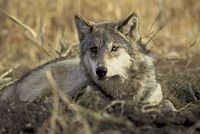 | ||||||||||||||||||
| Scientific classification | ||||||||||||||||||
| ||||||||||||||||||
|
Carnivora is an order of mammals that includes such familiar groups as dogs, cats, bears, and seals. There are over 260 species in Carnivora.
The word "Carnivora" comes from the Latin words carō, meaning "flesh," and vorāre, meaning "to devour," and thus means "to devour flesh." Carnivores in general get most of their food by killing and eating other animals, including other mammals, birds, insects, and fish. However, many are omnivores and get a large part of their nutrition from plant foods. The giant panda (Ailuropoda melanoleuca) and a few other members of Carnivora are almost exclusively herbivores. (The panda occasionally eats fish, eggs, and insects.)
While the term carnivore is popularly (and acceptably) used to refer to any meat-eating animal, in taxonomy the name "carnivore" specifically refers to any member of the order Carnivora, including those that are herbivores. However, in this article, the term carnivore will be limited specifically to members of Carnivora.
Carnivores are a key part of the remarkable harmony in nature, where an incredible diversity of plants, animals, and microorganisms exist, all in stunning balance and for millions of years. One explanation for this continuing harmony is the fact that the various taxa not only seek their own individual purpose (survival, maintenance, reproduction, etc.), but also serve a purpose for the whole. In the case of carnivores, by consuming various animals lower in the food chain, they help to maintain acceptable population levels. Removal of carnivores (and many are apex predators, at the end of the food chain) and the prey populations could explode in numbers and overwhelm the ecosystem. Human activities sometimes result in removal of important carnivores, and even extinction of particular populations or species, disrupting the delicate balance.
Members of Carnivora are placed into two main sub-orders: Feliformia (cat-like) and Caniformia (dog-like). Some of the major sub-groups within Feliformia are the families Felidae (cats), Hyaenidae (hyenas), and Herpestidae (mongooses). Some of the major sub-groups within Caniformina are the families Canidae (dogs, wolves, and foxes), Ursidae (bears), Mustelidae (weasels, badgers, and otters), and Mephitidae (skunks), as well as the pinnipeds (seals, sea lions, and walruses).
Characteristics
Carnivores have a characteristic skull shape. Their dentition includes prominent canines and carnassials, while the molars are blade-like and more suited for cutting than grinding. Carnivores, unlike many other mammals, can not move their lower jaws from side to side but can only open and close their mouths.
Except for the aquatic pinnipeds, which have both front and hind limbs in the form of flippers, carnivores walk on all four legs. Some, like cats and dogs, walk on their toes, and some, like bears and raccoons, on the flat of the feet like humans. The bodies of most are covered with thick fur. Almost all carnivores have tails, which are used in various ways by different species. The binturong, or bearcat (Artictis binturong), has a prehensile tail (Voelker 1986).
Most carnivores bear young once a year. The number of young ranges from one, in the Pinnipedia, to as many as 16 or more, in the African wild dog (Lycaon pictus). The young are born small and helpless and are looked after for a fairly long time by their mothers. In most cases, this includes time for learning hunting and other life skills. Some carnivores, such as wolves (Canis lupus) and lions (Panthera leo), live in groups and help each other rear and protect the young (Nowak 1983).
All carnivores have scent glands in their anal regions. The secretions from these are often used to mark territories. In skunks and some others, they are used as a defensive weapon (UCMP 2007).
Carnivores range in size from the least weasel (Mustela nivalis), which weighs from 35 to 70 grams (1.25 to 2.5 ounces), to the Southern elephant seal (Mirounga leonina) which can weigh 4000 kg (9000 lbs). The largest land carnivore is the brown or grizzly bear (Ursus arctos) which can weigh as much as 780 kg (1700 lbs) (Nowak 1983).
Role in nature
Carnivores are found in almost all land habitats over most of the world. Australia has no land carnivores except those introduced by humans, among them the dingo (Canus familiaris dingo), which is a feral dog introduced in prehistoric times, and cats and foxes, which were introduced later. All large native land mammals in Australia are marsupials. Pinnipeds are found in the coastal waters and shores of all continents, including Australia and Antartica (Voelker 1986).
Carnivores play an important role in nature by helping to control the numbers of other animal species. This protects the plants from overgrazing and keeps the ecosystem in balance. Another important role is eating the bodies of animals that have died.
Carnivores and humans
Many of the larger carnivores can be dangerous to humans and to domestic animals, and have been killed or driven away from their habitats for that reason. On the other hand, carnivores play a vital role in keeping the population of rodents and other potentially destructive animals under control. Some carnivores are trapped and hunted for their fur, as well as for meat and for sport. Hunting and loss of habitat due to human activities have caused the extinction of some carnivore species and are now endangering others.
Two carnivores that have become very successful in partnership with humans are the domestic dog and cat (Canis familiaris and Felis catus). Other carnivores are popular attractions in zoos, circuses, and animal parks.
Phylogeny
Older classification schemes divided the order Carnivora into two suborders, Fissipedia (which included the families of primarily land Carnivora) and Pinnipedia (which included the true seals, eared seals, and walrus). However, even at the time, it was recognized that the Fissipedia was a paraphyletic group: The pinnipeds were not the sister group to the fissipeds, but rather had arisen from among them.
Newer classification schemes have been able to integrate the findings from molecular techniques for discovering genetic relationships. They generally divide the Carnivora into the suborders Feliformia (cat-like) and Caniformia (dog-like), the latter of which includes the pinnipeds. The pinnipeds are part of a clade, known as the Arctoidea, which also includes the bears and the superfamily Musteloidea. The Musteloidea in turn consists of the mustelids, procyonids, skunks, and Ailurus. The dogs are the sister group to the entire arctoid assemblage; they are considered to have been the first of the extant (living) caniforms to split from the others.
The same studies resolve the position of Ailurus: The red panda is considered neither a procyonid nor an ursid, but rather forms a monotypic family with the other musteloids as its closest living relatives. The same study also suggests that the mustelids are not a primitive family, as was once thought. Their small body size is considered a secondary trait: The primitive body form of the arctoids was large, not small.
Recent molecular studies suggest that the endemic Carnivora of Madagascar—including three genera usually classed with the civets and four genera of mongooses classed with the Herpestidae—are all descended from a single ancestor. They form a single sister taxon to the Herpestidae. The hyenas are also closely related to this clade.
The exact position of the cats in relation to the other families is somewhat disputed. Nandinia, the African palm civet, seems to be the most primitive of all the feliforms and the very first to split from the others. The Asiatic linsangs of the genus Prionodon (traditionally placed in the Viverridae) might form a family of their own as well, as some recent studies indicate that Prionodon is actually the closest living relative to the cats.
The position of extinct Carnivora families is not clear. Recent studies suggest that the ancient families Miacidae and Viverravidae are not basal members of the Caniformia and Feliformia, so they are not the direct ancestors of any living Carnivora family (Wesley-Hunt and Flynn 2005).
The Miacidae is not even monophyletic, rather it appears to represent a paraphyletic array of stem taxa. Traditionally, the Miacidae and the Viverravidae have been classified in a third, extinct paraphyletic superfamily, the Miacoidea, from which the direct ancestors of the other two superfamilies arose.
The Nimravidae are sometimes seen as the most basal of all feliforms, and the first to split from the others. Other studies indicate that Barbourofelids forms a separate family, which is closely related to the true felids instead of being related to the Nimravids. The position of many extinct felids is not clear: They may or may not be true cats after all. The amphicyonids are the first of the caniforms to split off; they are not the sister group to the ursids (as most scientists once thought), but are rather an out group to all other caniforms.
The results of the same study (Wesley-Hunt and Flynn 2005) further suggest a much younger minimum age for the crown-clade Carnivora (the divergence age of the subclades Caniformia and Feliformia) than had been inferred in many previous studies: Middle-Eocene (ca. 43 million years ago), rather than early Paleocene (60 Ma). It remains unknown if the Creodonta are the closest relatives of the Carnivora, but it seems they are. They are united with the Pholidota and some extinct orders in the clade Ferae.
Classification
- ORDER CARNIVORA
- Suborder Feliformia ("cat-like")
- ?Family †Viverravidae (33-65 Ma)
- Family †Nimravidae: false sabre-tooth cats (5-36 Ma)
- Family Nandiniidae: African Palm Civet; 1 species in 1 genus
- Infraorder Feloidea
- Family Prinonodontidae: Asiatic linsangs; 2 species in 1 genus
- Family †Barbourofelidae (6-18 Ma)
- Family Felidae: cats; 40 species in 14 genera
- Infraorder Viverroidea
- Family Viverridae: civets and allies; 35 species in 15 genera
- Superfamily Herpestoidea
- Family Hyaenidae: hyenas and aardwolf; 4 species in 3 genera
- Family Eupleridae : Malagasy carnivores; 8 species in 7 genera
- Family Herpestidae: mongooses and allies; 33 species in 14 genera
- Suborder Caniformia ("dog-like")
- ?Family †Miacidae (34-64 Ma)
- Family †Amphicyonidae: Bear-dogs (9-37 Ma)
- Family Canidae: dogs and allies; 37 species in 10 genera
- Infraorder Arctoidea
- Family †Hemicyonidae: (35-50 Ma?)
- Family Ursidae: bears; 8 species in 4 genera
- Superfamily Musteloidea
- Family Ailuridae: Red Panda; 1 species in 1 genus.
- Family Mephitidae: skunks and stink badgers; 10 species in 4 genera
- Family Mustelidae: weasels, martens, badgers, and otters; 55 species in 24 genera
- Family Procyonidae: raccoons and allies; 19 species in 6 genera
- (Superfamily) Pinnipedia
- Family †Enaliarctidae: (23-20 Ma?)
- Family Odobenidae: Walrus; 1 species in 1 genus
- Family Otariidae: sea lions, eared seals, fur seals; 14 species in 7 genera
- Family Phocidae: true seals; 19 species in 9 genera
- Suborder Feliformia ("cat-like")
Cladogram
| Carnivora |
| ||||||||||||||||||||||||||||||||||||||||||||||||||||||||||||||||||||||||||||||||||||||||||||||||||||||||||||||||||||||||
ReferencesISBN links support NWE through referral fees
- Nowak, R. M., and J. L. Paradiso. 1983. Walker's Mammals of the World. Baltimore: The Johns Hopkins University Press. ISBN 0801825253
- University of California Museum of Paleontology (UCMP). 2007. Introduction to the Carnivora. Retrieved May 4, 2007.
- Voelker, W. 1986. The Natural History of Living Mammals. Medford, New Jersey: Plexus Publishing, Inc. ISBN 0937548081
- Wesley-Hunt, G. D., and J. J. Flynn. 2005. Phylogeny of the Carnivora: Basal relationships among the carnivoramorphans, and assessment of the position of "Miacoidea" relative to Carnivora. Journal of Systematic Palaeontology 3: 1-28. Retrieved May 6, 2007.
Credits
New World Encyclopedia writers and editors rewrote and completed the Wikipedia article in accordance with New World Encyclopedia standards. This article abides by terms of the Creative Commons CC-by-sa 3.0 License (CC-by-sa), which may be used and disseminated with proper attribution. Credit is due under the terms of this license that can reference both the New World Encyclopedia contributors and the selfless volunteer contributors of the Wikimedia Foundation. To cite this article click here for a list of acceptable citing formats.The history of earlier contributions by wikipedians is accessible to researchers here:
The history of this article since it was imported to New World Encyclopedia:
Note: Some restrictions may apply to use of individual images which are separately licensed.
